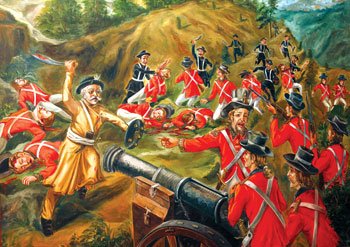
In the early long periods of nineteenth century, Gurkhas from Nepal ruled Simla or now called Shimla. In 1804 the Sikh armed force moved up to the hills and battled against Gurkhas. At Kangra the Gurkhas experienced serious thrashing from the Sikh army. Subsequent to losing a large number of their soldiers, they moved to Shimla, assaulted the encompassing hill states, and made an awesome level of disturbance. It is said that they ate so many goats that the cost of this valuable creature rose to Rs. 30/ – per head.
Udham Singh Kumar an author from that point says in one of his articles that Gurkhas built numerous fortresses around Shimla to have a solid base here.
Jagatgarh Fort
Directly it is known as Jutogh and is the base of Indian Army. Served by a Railway Station on the course of Kalka Shimla Railway, Jutogh today is a notable region toward the west of Shimla. After the war with Gurkhas was finished and Shimla was straightforwardly controlled by the British, Jutogh turned into a cantonment. Jutog is encompassed by a little hill and outside the slopes another town called Tutu has been created. The tale of Tutu says that amid the Raj the security contingent of the Viceroy was situated around there which had twenty two security men. On account of its number they called it “Two-Two” and the region got the name.
Subathu Fort
Another fort that they built was in village Subathu or locally called Sapatoo, 55 kilometres down the hills from Shimla. After defeating Gurkhas, the British established a cantonment here that still exists. Subathu cemetery and Subathu Garrison Cemetery holds a great amount of history in its bosom.
Shyamala Fort
Despite the fact that this name isn’t specified in the history yet I am risking naming it so in light of the fact that the fort was based on the slope where later Bntinck’s Castle was constructed. Now, the building of Grand Hotel stands on it. Later during the time of Lord William Bentinck, Simla was truly procured by the Government of India. The Lord understood that there was no reasonable place for him to remain in Shimla, he moved to Ooty and ordered to build a house for him in Shimla, for his following visits. At that time an old Dak Bungalow was there at the hilltop, which was wrecked to make space for Bentinck’s Castle.
Sanjauli Fort
Snajauli presently is a suburb of Shimla and it possessed by the general population from the upper regions. The peak where the Gurkhas built their fortress has now been supplanted by a temple called ‘Dhingu Mandir’. A British Cemetery, also called Sanjauli cemetery, still utilized by the Indian Christians is there.
End of Gurkha War
The Journal of a tour through part of the Himalaya Mountains by James Baillie Fraser, published in 1820 says, “This power emboldened by a long course of success and conquest had commenced a deliberate system of encroachment on British boundaries, and a course of insult towards its lower ministers which at length it became absolutely necessary to repel.”
Under the command of General David Ochterlony, his army with under 3000 men climbed to the hills and assaulted Arki, 40 km toward the west of Shimla, where Amar Sing Thapa, the Gurkha General was based. The vast majority of the rulers from the slopes upheld the British.
The regiment of Gurkha Army based a Maloun was called Malaun Regiment where the last war between the British and the Gurkhas occurred. Bhakti Thapa, an acclaimed Gurkha leader, was killed during this war and all others of his fellowmen declined to proceed and dispersed. Because of this, Amar Singh Thapa surrendered on 15th May and that finished the Gurkha period in Shimla.
General David Octorlony demonstrated a regard for the carcass of Bhakti Thapa and enclosed by costly shawls, he sent it to Amar Singh Thapa. Next morning the two widows of the dead General committed ‘suttee’ with his body. The hill chieftains who had upheld the British were permitted to have their territories and General Octorlony guaranteed to give them full insurance.
A different Battalion was shaped named as Nasuree Battalion in which every one of the Gurkhas warriors who had lost the job were taken. This was based at Subathu and still is, as Gorkha Rifles.
Till the Raj finished the hill people talked the Gurkha control and its savagery. A local author stated, ‘The Gurkha army had no law to guide them, nor did they care for peace and prosperity. They valued their luxuries far above the rights of others, and hence their rule in the hills is regarded as nothing but a plague infection, ruinous to the hill subjects under them, and eventually to themselves . . . They took mercy upon nobody, nor did the idea of universal brotherhood ever occur to them. They had such a desire for revenge that if even a stone hurt their bare feet, they would not go further so long as it was not ground into powder.

